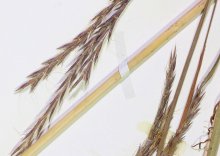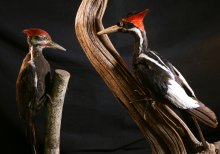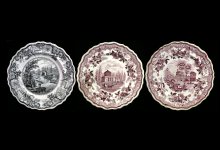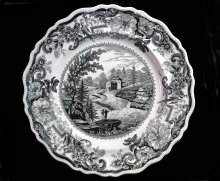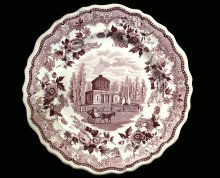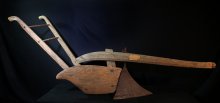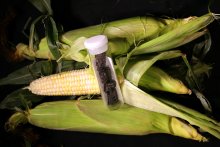Early Statehood (1818-1848)
On December 3, 1818, Illinois became the twenty-first state of the Union. Ostensibly a free state, slavery was “grandfathered” in to the constitution for existing colonial slaveholders, and all citizens were permitted to keep indentured servants. Over the next thirty years, the state experienced a transition from an American frontier to a settled and rapidly developing agricultural state. Technology changed agriculture and expanded markets. It also fostered changes in government, legal, and educational institutions.
In 1832, Black Sparrow Hawk, a Sauk warrior, and more than 1,000 Sauk and Fox, attempted to return to their principal community of Saukenuk, present-day Rock Island. Conflict soon followed, and warriors fought a series of battles with Federal troops and Illinois militia in Illinois and Wisconsin. Decimated in a final fight at Bad Axe in Wisconsin, the Sauk and Fox, along with other tribes once resident in Illinois, signed a treaty reaffirming their land cessions and moved to reservations west of the Mississippi River.
The land that was to become the State of Illinois was once two-thirds covered by prairie. Big Bluestem (Adropogon gerardii) may have been the most widespread and abundant grass on the prairie. Big Bluestem grows in such tall and dense stands that it often outcompetes other grasses.
The Greater Prairie Chicken (Tympanuchus cupido) once numbered in the millions in Illinois. At first, as the Illinois prairie was converted to farmland, prairie chickens grew in numbers. But as the ratio of farmland to prairie grew more lopsided, prairie chickens declined in number, leaving a small, remnant population on two preserves in southern Illinois.
This specimen of the Ivory-billed Woodpecker (Campephilus principalis) (here compared with the common Pileated Woodpecker on the left) is not from Illinois. The only Illinois records we have are observations from naturalists, mostly in the 1800s. John James Audubon, the famous bird artist, encountered calling Ivory-billed Woodpeckers in the 1820s on both sides of the Ohio River where it meets the Mississippi River at Cairo. Southern Illinois was the far northern extent of the species at that time.
The unmistakable ridges of the carapace (or shell) tell us right away that this prehistoric-looking creature is the Alligator Snapping Turtle (Macrochelys temminckii). It is our largest freshwater turtle, weighing up to 200 pounds. They lie in wait for prey submerged underwater and try to lure a meal into range by means of a wormlike appendage on the floor of their mouths. When a fish or other aquatic animal moves in to investigate, the turtle snaps its jaws shut.
These fragments were discovered during an investigation of a well that had been filled in at the Williams Fort site in southeastern Illinois. The site was the location of a farmstead occupied by the family of Aaron and Tabitha Williams from about 1811-1838. To defend against the possibility of attack by Native Americans during the War of 1812, a stockade was constructed. A tavern was operated at the site in the years following the war.
Although the “Baker’s Falls” plate was made by James and Ralph Clews, and the “Water Works” and “Race Works” plates were made by Job and John Jackson, all three plates are identical in diameter and apparently were made from the same mold. Note that they all share the same scalloped rim edged with raised dots. We don’t know if the Jacksons obtained the molds from the Clews pottery through gift, purchase, or outright theft. The Jacksons were nephews of James and Ralph Clews and trained at the Clews pottery in Cobridge, Staffordshire, England before setting out on their own.
The transfer plate process allowed producers of Staffordshire earthenware plates to produce ever-more detailed works of art, but that was not enough to stay ahead of the competition. The business was rife with labor strife, cutthroat competition, and theft of artwork and designs. This plate was made by the pottery of brothers James and Ralph Clews, located in Staffordshire, England. Opened at about the time Illinois became a state, the Clews continued in operation until 1835. The Clews pottery was a major exporter to the United States, and its ceramics were a familiar sight in Illinois homes.
Even in frontier Illinois, families sought out nice things for their homes. This plate is typical of those used on the Illinois frontier in the 1830s. It was produced by the pottery of brothers Job and John Jackson, located in Staffordshire, England. Operating their pottery from 1831–1835, the Jacksons produced a large amount of pottery for export to the United States, and pottery from the Staffordshire region dominated the Amerian market at the time. Fragments of their wares have been found at archaeological sites across Illinois, including Woodlawn Farm outside Jacksonville.
This iron moldboard plow was brought to LaSalle County from Connecticut by the Smith family in 1834. It was used to break the prairie on the Smith’s farm, twelve miles north of Ottawa.
Pages






